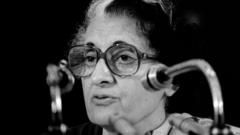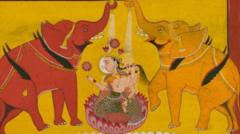This article delves into the significant events and consequences of the Emergency declared by Indira Gandhi, showcasing the impact on civil rights, political opposition, and the media.
**Indira Gandhi's Emergency: A Dark Chapter in India’s Democratic Journey**

**Indira Gandhi's Emergency: A Dark Chapter in India’s Democratic Journey**
A look back at the 1975 Emergency period in India when civil liberties were suspended under Indira Gandhi's rule.
At midnight on June 25, 1975, India's democracy faced an unprecedented crisis as Prime Minister Indira Gandhi announced a nationwide Emergency. In an effort to curb growing political unrest and street protests led by socialist leader Jayaprakash Narayan, the government suspended civil liberties, jailed opposition figures, and imposed strict censorship, rendering the constitution a mere instrument of executive power.
The Emergency was prompted by the Allahabad High Court's ruling that invalidated Gandhi’s election due to electoral malpractice, which ignited public outrage. In response, Gandhi declared an "internal emergency" under Article 352 of the constitution, claiming a threat to national stability. Historian Srinath Raghavan highlights how this led to a dramatic increase in executive power, largely unchecked by judicial oversight, with over 110,000 arrests reported.
The consequences were dire; notable political leaders like Morarji Desai and LK Advani were detained, while various groups were silenced under oppressive laws. The judiciary was compromised, with an alarming rate of detentions occurring without legal recourse, leaving citizens powerless to challenge violations of their rights.
A controversial family planning initiative, widely perceived as influenced by Sanjay Gandhi, resulted in the forced sterilization of millions of Indians, illustrating the draconian policies of the regime. Reports emerged from areas like Delhi’s “Castration Colony”—where women lamented the drastic consequences of state-mandated procedures on their personal lives.
Moreover, the Emergency facilitated a slum clearance program, displacing hundreds of thousands as the government sought to "clean up" urban areas. Some of the most tragic incidents occurred in Delhi's Turkman Gate, where police violence resulted in multiple fatalities during protests against demolitions.
As the media faced harsh restrictions, censorship enveloped the press overnight—newspapers were forced to print blank editorial spaces to protest against the gag orders. Major international journalists were expelled for defying censorship agreements, further isolating Indian media from the global narrative.
Sanjay Gandhi’s influence extended beyond family planning to social policies, with his five-point agenda blending personal initiatives with state governance. During this turbulent period, the workforce experienced severe repression, with trade unions crushed and strikes virtually eliminated, leading to a temporary economic revival praised by some business leaders.
Despite the Emergency's brutal tactics, some perceived it as a time of order, citing improved industrial productivity and public safety. However, the sociopolitical ramifications left behind a legacy of fear and repression that continued long after the Emergency ended in March 1977.
Historian Gyan Prakash warns that viewing the Emergency as a mere historical aberration overlooks the fragility of democratic structures and governance. This period serves as a stark reminder of the importance of vigilant civil society and robust institutions in preserving democracy, echoing BR Ambedkar's cautions against unchecked political devotion.
Today, India's Emergency remains a vital chapter in its history, prompting reflection on civil liberties and the balance of power, and illustrating the need for safeguarding democratic principles against authoritarian impulses.
The Emergency was prompted by the Allahabad High Court's ruling that invalidated Gandhi’s election due to electoral malpractice, which ignited public outrage. In response, Gandhi declared an "internal emergency" under Article 352 of the constitution, claiming a threat to national stability. Historian Srinath Raghavan highlights how this led to a dramatic increase in executive power, largely unchecked by judicial oversight, with over 110,000 arrests reported.
The consequences were dire; notable political leaders like Morarji Desai and LK Advani were detained, while various groups were silenced under oppressive laws. The judiciary was compromised, with an alarming rate of detentions occurring without legal recourse, leaving citizens powerless to challenge violations of their rights.
A controversial family planning initiative, widely perceived as influenced by Sanjay Gandhi, resulted in the forced sterilization of millions of Indians, illustrating the draconian policies of the regime. Reports emerged from areas like Delhi’s “Castration Colony”—where women lamented the drastic consequences of state-mandated procedures on their personal lives.
Moreover, the Emergency facilitated a slum clearance program, displacing hundreds of thousands as the government sought to "clean up" urban areas. Some of the most tragic incidents occurred in Delhi's Turkman Gate, where police violence resulted in multiple fatalities during protests against demolitions.
As the media faced harsh restrictions, censorship enveloped the press overnight—newspapers were forced to print blank editorial spaces to protest against the gag orders. Major international journalists were expelled for defying censorship agreements, further isolating Indian media from the global narrative.
Sanjay Gandhi’s influence extended beyond family planning to social policies, with his five-point agenda blending personal initiatives with state governance. During this turbulent period, the workforce experienced severe repression, with trade unions crushed and strikes virtually eliminated, leading to a temporary economic revival praised by some business leaders.
Despite the Emergency's brutal tactics, some perceived it as a time of order, citing improved industrial productivity and public safety. However, the sociopolitical ramifications left behind a legacy of fear and repression that continued long after the Emergency ended in March 1977.
Historian Gyan Prakash warns that viewing the Emergency as a mere historical aberration overlooks the fragility of democratic structures and governance. This period serves as a stark reminder of the importance of vigilant civil society and robust institutions in preserving democracy, echoing BR Ambedkar's cautions against unchecked political devotion.
Today, India's Emergency remains a vital chapter in its history, prompting reflection on civil liberties and the balance of power, and illustrating the need for safeguarding democratic principles against authoritarian impulses.



















